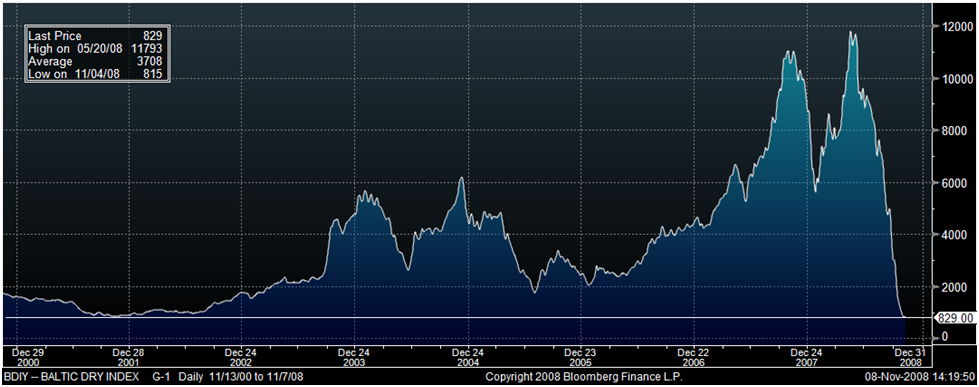I have been receiving a significant amount of email regarding an old entry I wrote back in March 2008 regarding the Baltic Dry Index (BDI). Back in March the BDI was recovering for an interim low it experienced in January on fears of a global economic slowdown, however, since then the situation has become far worse. The BDI is now trading at levels not seen since 2001. To help put this into perspective a recent article by “The Independent” noted that in the beginning of June the total cost of a shipment of coal from Brazil to China would have totaled USD15mn per voyage compared to USD1.5mn currently. At the same time, the article noted that the daily cost of chartering a capsize bulk carrier during this cycle's peak amounted to USD234.0K vs. USD5.6K presently. This is a drop of around 98%!
The Baltic Dry Index's recent plunge
Now on to what is important… Why has this happened? Unlike the drop the index experienced earlier this year, based primarily over concerns of a global economic slowdown; the current plunge also takes into account the ongoing liquidity crisis and commodity deflation. The shipping industry relies heavily on an instrument called “Letters of Credit” (LC), which is a guarantee issued by a bank that the buyers funds will be transferred to the seller at the completion of the transaction (i.e. traded goods properly received). As liquidity tightened around the world so has the issuance of these instruments, further slowing global trade. According to Trade Finance Magazine to cope with this, the market has begun to see a resurgence in export credit (i.e. the seller issues loan to the buyer via an export credit agency), but as the magazine pointed out this is a “relatively slim corridor”, and holds significantly more risk for the exporter compared to a traditional LC.
As if this alone were not bad enough it would appear that deflation in commodity prices has caused many companies to begin using up raw material inventories rather than importing new stocks. This is basic economics, why buy something today that will be cheaper tomorrow? Nonetheless, these industries will eventually run low enough on inventories where they will be forced to purchase more, which should put some upward pressure on shipping costs.
The CRY Commodity Index has also dropped significantly
If prolonged this ’suspension’ in global trade will have significant adverse effects for export oriented economies, and increase the likelihood of further reductions to 2009 growth rates . Nonetheless, I do believe that as companies run low on inventory and as global credit markets continue to unlock we will see a stabilization and marginal recovery in shipping costs. However, it is unlikely we will see BDI levels anywhere close to those at the beginning of this year anytime before the end of this decade. In the short-term yet another piece of negative news for the global economy...
As an aside I created a monthly market cap weighted shipping index starting in May 2005 to compare against the BDI. I used the following companies for the index 1) AP Moller - Maersk 2) Mitsui OSK Lines 3) China Shipping Development Co 4) Nippon Yusen 5) Kawasaki Kisen Kaisha 6) Evergreen Marine Corp 7) Orient Overseas International 8) Neptune Orient Lines 9) Hanjin Shipping Co. & 10) CSC Nanjing Tanker Corp. Maersk alone makes up roughly 50% of the total market vap of the index.












